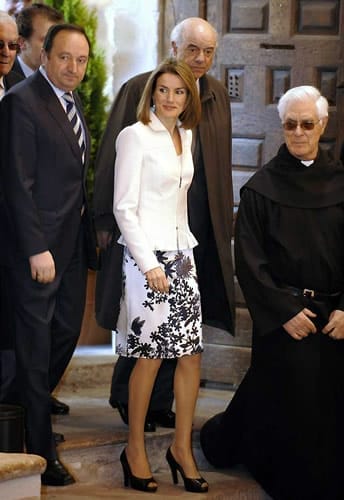The Introduction was done by the Prior of the Monastery Juan Angel Nieto, the president of the Agency EFE, Alex Grijelmo, the director of the Mexican Academy of the Spanish Language and president of the FUNDÉO México, José Moreno de Alba, and the president of BBVA, Francisco González.
The Princess of Asturias arrived by helicopter in the Riojan locality around midday and was welcomed by the President of the Rioja and other dignitaries who then accompanied her into the Monastery of Yuso. The seminar organised by the Foundation San Millán de la Cogolla and FUNDEU-BBVA, lasted three days during which the language experts, philologists, scriptwriters and writers expounded on the language used by young people.
Among the participants were the director of the Real Academia, Víctor García de la Concha; the presidents of BBVA, Francisco González, and the Agencia EFE, Alex Grijelmo; the director general of the Mexican news agency Notimex, Sergio Uzeta; and the director general of Fundéu BBVA, Joaquín Muller.The Fundéu de México, publicly presented a year ago at the National Book Fair in Guadalajara is among the first of a series of foundations dedicated to protecting the Spanish language and spreading its correct use in the world.
The Princess and the journalist
Princess Letizia explained how "we are all responsible for the language for we use it to communicate and it is after all our principal cultural asset." In her speech the Princess of Asturias highlighted that "around 500 million people share this language so we ought always to study it". In this sense she explained that "in the next few days a group of experts will help us to comprehend something so simple yet so immense: how to communicate better. You will reflect on how the young people use our language".
On his part the director of the Real Academia Española, Victor García de la Concha, explained how a civilization so dominated by the audio visual was impoverishing its ability to express itself in words. "A language, he added, is what its speakers make of it and so the theme chosen for the seminar "Spanish among the young” was fundamental".
The president of the La Rioja, Pedro Sanz, noted that the seminar will once more make it possible for this community "to be the reference point for the study of our language". Along these lines he remembered that “his Majesty, the King, had pointed out on many occasions that language is the most important cultural asset that we have". Because of this, he reassured them that the Fundación San Millán "will use all the means at its disposal to make sure that Spanish will reach the world wide recognition that corresponds to it".
The Cradle of the Language
More or less a thousand years ago a monk of San Millán was in front of a codex written in latin. He was taking notes in an attempt to understand the grammar and clarify some words. This was just one more exercise of the Trivium. These notes are called the Glosas Emilianenses, the first known text written in castillian (Spanish) This rough translation “is written in the language of the people, in romance, and is held to be the first page of Spanish literature. In the right hand margin of page 72 of the Codex Emilianense number 60 we read a doxology, a prayer of praise, which is in part a translation from the latin and part from the pen of the writer. It’s interesting to note that in other pages of the same codex we find two annotations written by the same monk in basque. This is the oldest written witness to the said language that is still extant.


